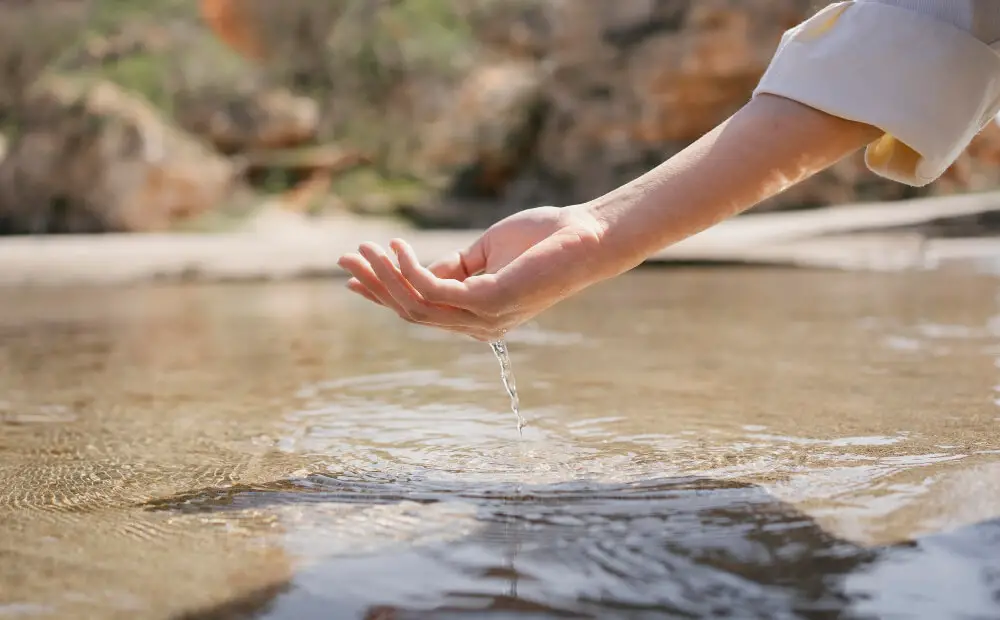In today’s world, where health and well being are paramount, the source of your drinking water becomes a critical choice. Two common options that often come into consideration are well water and spring water. Both have their unique qualities and advantages.
In this comprehensive comparison, we delve into the world of water sources to help you make an informed decision about what flows from your tap.
Well Water
Well water is sourced directly from the ground through a well. The quality of well water can vary significantly depending on the location and depth of the well.
It typically contains minerals like calcium and magnesium, which can give it a distinct taste.
Spring Water
Spring water, on the other hand, naturally flows to the surface from underground springs. Springs are openings in the Earth’s surface where groundwater emerges due to natural pressure.
Differences Between Well Water and Spring Water
Well water and spring water are both natural sources of groundwater, but they have some key differences in terms of their origins, characteristics, and quality.
Here are some of the main differences between well water and spring water:
1. Source of Origin
- Well Water: It comes from underground aquifers, which are essentially layers of water-bearing rock or sediment beneath the Earth’s surface. Wells are dug or drilled to access this water.
- Spring Water: It originates from natural springs, which are points where groundwater naturally flows to the surface. Springs can be found in various terrains, including mountains, hillsides, or valleys.
2. Collection Method
- Well Water: Well water is collected by drilling or digging a well into the underground aquifer. The water is pumped up to the surface for use.
- Spring Water: Spring water can be collected directly from the surface where it emerges or by drilling a well near the spring source to tap into the underground water source.
3. Mineral Content
- Well Water: The mineral content of well water can vary widely depending on the geological composition of the aquifer it comes from. It may contain higher levels of certain minerals, such as calcium, magnesium, or iron, which can affect its taste and suitability for various uses.
- Spring Water: Spring water is often perceived as having a pure and clean taste due to its natural filtration through rock and soil. The mineral content in spring water is generally balanced, and some people prefer it for drinking due to its perceived freshness.
4. Contamination Risks
- Well Water: Well water can be vulnerable to contamination from various sources, such as nearby septic systems, agricultural runoff, or industrial pollutants. Regular testing and treatment may be necessary to ensure its safety.
- Spring Water: Spring water is often considered less susceptible to contamination because it undergoes natural filtration as it flows through underground layers before reaching the surface. However, it can still be affected by environmental pollutants or microbial contamination.
5. Sustainability
- Well Water: The sustainability of well water depends on the rate at which the aquifer is recharged by natural processes. Over pumping or excessive use of well water can lead to aquifer depletion, which is a concern in some areas.
- Spring Water: Springs are typically fed by ongoing natural processes, and as long as the water source remains protected, spring water can be considered a sustainable water source.
6. Taste
- Well water: Well water can have a variety of tastes, depending on the mineral content of the aquifer. Some people find that well water has a “hard” taste, while others find it to be refreshing.
- Spring water: Spring water is often described as having a “clean” or “fresh” taste. This is because of its low mineral content.
How are Water well and Spring Water Collected?
Water wells and spring water are collected using different methods due to their distinct sources.
Here’s an overview of how each is collected:
Water Well Collection
- Drilling: Water wells are typically created by drilling deep into the ground until a reliable source of groundwater is reached. The depth of the well depends on the local hydrogeology, and it can range from a few tens of feet to several hundred feet or more.
- Well Casing: A well casing, usually made of steel or PVC, is inserted into the drilled hole to prevent the well from collapsing and to keep out contaminants. The casing also helps to control the flow of water.
- Screen or Perforations: Near the bottom of the casing, a screen or perforated section is installed to allow water to enter the well while keeping out sand and debris.
- Pump System: A pump is installed within the well, either submerged in the water or positioned above it. This pump draws water from the ground and delivers it to the surface, where it can be stored and distributed for various uses.
- Water Testing: Regular water testing is essential to ensure the quality and safety of well water. Testing can reveal any contaminants and help determine if any treatment is necessary.
Spring Water Collection
- Natural Springs: Spring water is sourced from naturally occurring springs, where groundwater flows to the surface due to geological formations or aquifers. Springs can be found in various terrains, such as mountains, hills, or valleys.
- Collection Basin: A collection basin or wellhead is built around the spring source to capture the flowing water. This basin is designed to protect the spring from contamination and to facilitate the collection of water.
- Gravity Flow: In many cases, spring water is collected using a gravity flow system. The water flows from the spring source into a collection point, where it can be stored or immediately bottled for consumption. This method minimizes the need for mechanical pumps.
- Filtration (optional): Some spring water sources may undergo minimal filtration to remove larger debris and particles, but the water is generally considered naturally filtered by passing through the earth.
- Bottling: Once collected and, if necessary, filtered, spring water is often bottled for distribution. It is crucial to maintain the water’s purity and integrity during the bottling process to preserve its natural qualities.
- Regulation: Spring water bottling facilities are subject to regulations to ensure the quality and safety of the water. The U.S. Food and Drug Administration (FDA) regulates the bottling and labeling of spring water in the United States.
Benefits of Well Water and Spring Water
Well Water
- Cost Efficiency: Well water is generally more cost-effective as it doesn’t require extensive transportation or purification processes.
- Mineral Content: The minerals in well water can contribute to your daily mineral intake, promoting overall health.
- Mineral Rich: Well water often contains essential minerals like calcium and magnesium, which can be beneficial for your health.
- Cost Efficient: Since it’s sourced on your property, you save on water bills.
- Low Environmental Impact: Well water doesn’t require transportation, reducing its carbon footprint.
Spring Water
- Natural Purity: Spring water is typically free from contaminants, thanks to natural filtration processes.
- Great Taste: Its clean, refreshing taste is a crowd-pleaser.
- Convenient Packaging: Available in bottles, making it easily accessible.
Well Water vs Spring Water: Which is Better for You
The choice between well water and spring water depends on various factors, including your location, the specific source of the water, personal preferences, and health considerations.
There isn’t a one size fits all answer to whether well water or spring water is “better” for you, as both can have advantages and disadvantages.
Here are some factors to consider when making your choice:
1. Water Source Quality
- Well Water: The quality of well water can vary significantly based on location and local conditions. Some well water sources may be clean and safe for consumption, while others may have contaminants that require treatment. Regular water testing is essential to assess well water quality.
- Spring Water: Spring water is often perceived as naturally pure due to its filtration through layers of rock and soil. However, the quality of spring water can also vary depending on the specific spring and its surroundings. Reputable spring water brands adhere to strict quality standards.
2. Taste Preferences
- Well Water: The taste of well water can vary widely depending on mineral content and local characteristics. Some people enjoy the unique taste of well water, while others may find it less appealing.
- Spring Water: Spring water is generally known for its fresh and clean taste. Many people prefer the taste of spring water over tap water or well water.
3. Mineral Content
- Well Water: The mineral content of well water varies based on geological conditions. Depending on the source, well water may provide essential minerals like calcium and magnesium.
- Spring Water: Spring water typically has a balanced mineral composition, which can be a source of beneficial minerals.
4. Convenience
- Well Water: Well water is often found in rural areas and on private properties. It can be convenient if you have easy access to a well, but it may require maintenance, testing, and possibly treatment.
- Spring Water: Spring water is typically available in bottled form, making it readily accessible to consumers. It’s a convenient option for those who prefer bottled water.
5. Cost
- Well Water: The cost of well water primarily involves the initial setup of the well and ongoing maintenance. Once in place, the cost can be relatively low.
- Spring Water: Bottled spring water is generally more expensive than well water due to the costs associated with collection, bottling, and distribution.
Conclusion
In the debate of well water vs. spring water, there is no one size fits all answer. The choice between these two natural water sources depends on your taste preferences, location, and priorities. Both well water and spring water can provide safe and refreshing hydration options. It’s essential to consider factors like taste, mineral content, and source sustainability when making your decision.
When choosing your water source, whether it’s from a well or a natural spring, remember that staying hydrated is the ultimate goal. The differences between these two options add variety to our choices, ensuring that there’s a perfect match for every palate.
Frequently Asked Questions
Is it necessary to filter well water before consumption?
Filtering well water is advisable to remove any potential contaminants or sediment. Regular water testing can help determine the need for specific filtration methods.
Can well water taste different depending on the location?
Yes, the taste of well water can vary significantly based on the geological characteristics of the area and the minerals present in the water.






[…] can significantly impact our well-being. When it comes to water supply, two common options are well water and city water. Both have their advantages and disadvantages, making it crucial to understand the […]
[…] well water is good for you depends on several factors, such as the location of the well, quality, or water […]
[…] this article,we’ll explore effective methods to purify well water, and also explore the advantages of the methods to purify well […]
[…] Water softeners are devices designed to remove hardness minerals, primarily calcium and magnesium, from well water. […]
[…] drinkable well water comes from an aquifer, a storage component that collects it after it filtrates through a gravel […]
[…] will clarify whether it presents a threat to plant life, emphasize the significance of testing the well water, and analyze the advantages and disadvantages associated with using it as a method of irrigating […]
[…] the well water woes head-on, it eradicates iron stains, tackles rotten egg odors, combats manganese discoloration, […]